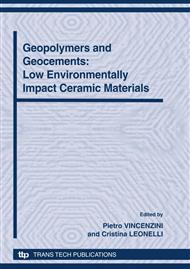p.107
p.117
p.123
p.129
p.135
p.143
p.152
p.156
p.164
Medium to Long Term Engineering Properties and Performance of High-Strength Geopolymers for Structural Applications
Abstract:
The medium to long term engineering performance of high-strength geopolymer concrete systems are largely dependent on fluid ingress and the transport phenomena that govern permeability of structural members exposed to aggressive environments. For the purpose of analysing durability performance, both high pressure water and gas permeability testing of fly-ash geopolymer(GP) concretes have been assessed for samples cured under ambient and steam exposure conditions at 65OC. The observed mean permeability coefficient values for gas(k) and water(Kw) of steam-cured structural grade concrete was respectively 6.19E-17m2 at 300kPa gas pressure and 1.52E-10m/s at 525kPa water pressure. While mean gas permeability values were comparable to reference steam-cured ordinary Portland cement(OPC) systems, the corresponding water permeability coefficient data for geopolymer concrete was ten-fold higher. The transport properties of OPC concrete systems are typically governed by water-to-cement ratio and the degree of hydration which is linked to the level of porosity and pore interconnectivity. However, corresponding permeability of geopolymer concrete appears to be dictated by an inherent mesoporous capillary pore network structure for which transport properties appear to be partly dependent on mode of concrete curing. The Paper examines global implications of increased permeability and key durability parameters such as chloride diffusion, carbonation rates and steel reinforcement corrosion on long-term engineering and durability performance.
Info:
Periodical:
Pages:
135-142
Citation:
Online since:
October 2010
Authors:
Keywords:
Price:
Сopyright:
© 2010 Trans Tech Publications Ltd. All Rights Reserved
Share:
Citation:


